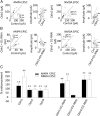Postsynaptic δ1 glutamate receptor assembles and maintains hippocampal synapses via Cbln2 and neurexin
- PMID: 29784783
- PMCID: PMC6003362
- DOI: 10.1073/pnas.1802737115
Postsynaptic δ1 glutamate receptor assembles and maintains hippocampal synapses via Cbln2 and neurexin
Abstract
The δ1 glutamate receptor (GluD1) was cloned decades ago and is widely expressed in many regions of the brain. However, its functional roles in these brain circuits remain unclear. Here, we find that GluD1 is required for both excitatory synapse formation and maintenance in the hippocampus. The action of GluD1 is absent in the Cbln2 knockout mouse. Furthermore, the GluD1 actions require the presence of presynaptic neurexin 1β carrying the splice site 4 insert (+S4). Together, our findings demonstrate that hippocampal synapse assembly and maintenance require a tripartite molecular complex in which the ligand Cbln2 binds with presynaptic neurexin 1β (+S4) and postsynaptic GluD1. We provide evidence that this mechanism may apply to other forebrain synapses, where GluD1 is widely expressed.
Keywords: Cbln2; GluD1; hippocampus; neurexin; synapse.
Conflict of interest statement
The authors declare no conflict of interest.
Figures








References
-
- Schmid SM, Hollmann M. Bridging the synaptic cleft: Lessons from orphan glutamate receptors. Sci Signal. 2010;3:pe28. - PubMed
-
- Kashiwabuchi N, et al. Impairment of motor coordination, Purkinje cell synapse formation, and cerebellar long-term depression in GluR delta 2 mutant mice. Cell. 1995;81:245–252. - PubMed
-
- Hirai H, et al. New role of delta2-glutamate receptors in AMPA receptor trafficking and cerebellar function. Nat Neurosci. 2003;6:869–876. - PubMed
-
- Uemura T, et al. Trans-synaptic interaction of GluRdelta2 and neurexin through Cbln1 mediates synapse formation in the cerebellum. Cell. 2010;141:1068–1079. - PubMed
Publication types
MeSH terms
Substances
Grants and funding
LinkOut - more resources
Full Text Sources
Other Literature Sources
Molecular Biology Databases
Miscellaneous

